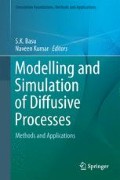Abstract
A numerical study of analyte preconcentration by isotachophoresis is made. We have considered a 2-D model of isotachophoresis (ITP). Both peak and plateau mode of ITP are investigated in the present analysis. The Nernst–Planck equation is used for ion transport, electroneutrality condition for the electric field along with the Navier–Stokes equations for fluid flow. Our numerical algorithm is based on a finite volume method along with a higher-order upwind scheme. The present numerical method resolves efficiently the thin region (transition zone) between two adjacent analytes, in which either a step change (plateau mode) or a steep gradient (peak mode) of variables occur. Validity of the Kohlrausch’s regulating function (KRF) for the computed solution in peak-mode ITP is analyzed. The dynamics of ions in ITP is studied for a wide range of parameter values such as mobility, electric field, and amount of the sample. The dispersion of ITP due to nonuniform fluid convection is also studied.
Access this chapter
Tax calculation will be finalised at checkout
Purchases are for personal use only
References
Li SFY (1992) Capillary electrophoresis: principles, practice, and applications. Elsevier, Amsterdam
Kuhn R, Hoffstetter-Kuhn S (1993) Capillary electrophoresis: principles and practice. Springer, Berlin
Camilleri P (1993) Capillary electrophoresis: theory and practice. CRC, Boca Raton
Landers JP (1994) Handbook of capillary electrophoresis. CRC, Boca Raton
Chen L, Prest JE, Fielden PR, Goddard NJ, Manz A, Day PJR (2006) Miniaturized isotacophoresis analysis. Lab-on-a-Chip 6:474–487
Gebauer P, Mala Z, Bovcek P (2011) Recent progress in analytical capillary isotachophoresis. Electrophoresis 32:83–89
Khurana TK, Santiago JG (2008) Preconcentration, separation, and indirect detection of nonfluorescent analytes using fluorescent mobility markers. Anal Chem 80:279–286
Garcia-Schwarz G, Bercovici M, Marshall LA, Santiago JG (2011) Sample dispersion in isotachophoresis. J Fluid Mech 679:455–475
Kohlrausch F (1897) Uber Concentrations-Verschiebungen durch Electrolyse im Inneren von Losungen und Losungsgemis. Ann Physik 62:209–239
Saville DA, Palusinski OA (1986) Theory of electrophoretic separations, Part I: Formulation of a mathematical model. AlChE J 32:207–214
Su Y, Palusinski OA, Fife PC (1987) Isotachophoresis: analysis and computation of the structure of the ionic species interface. J Chromatogr 405:77–85
Bercovici M, Lelea SK, Santiago JG (2009) Open source simulation tool for electrophoretic stacking, focusing, and separation. J Chromatogr A 1216:1008–1018
Thormann W, Breadmore MC, Caslavska RA, Mosher RA (2010) Dynamic computer simulations of electrophoresis: A versatile research and teaching too. Electrophoresis 31:726–754
Bhattacharyya S, Zheng Z, Conlisk AT (2005) Electroosmotic flow in two-dimensional charged micro- and nano-channels. J Fluid Mech 540:247–267
Baier T, Schonfeld F, Hardt S (2011) Analytical approximations to the flow field induced by electroosmosis during isotachophoretic transport through a channel. J Fluid Mech 682:101–119
Shim J, Cho M, Dutta P (2011) A method to determine quasi-steady state in constant voltage mode isotachophoresis. Electrophoresis 32:988–995
Saville DA (1990) The effects of electroosmosis on the structure of isotachophoresis boundaries. Electrophoresis 11:899–902
Schonfeld F, Goet G, Baier T, Hardt S (2009) Transition zone dynamics in combined isotachophoretic and electro-osmotic transport. Phys Fluids 21:092002
Bercovici M, Lelea SK, Santiago JG (2010) Compact adaptive-grid scheme for high numerical resolution simulations of isotachophoresis. J Chromatogr A 1217:588–599
Bhattacharyya S, Gopmandal PP, Baier T, Hardt S (2013) Sample dispersion in isotachophoresis with Poiseuille counter flow. Phys Fluids 25:022001–022015
Fletcher CAJ (1998) Computational methods for fluid dynamics, vol 2. Springer, Berlin
Jaluria Y (2003) Computational heat transfer. Taylor & Francis, New York
Leonard BP (1979) A stable and accurate convective modelling procedure based on quadratic upstream interpolation. Comput Meth Appl Mech Eng 19:59–98
Author information
Authors and Affiliations
Corresponding author
Editor information
Editors and Affiliations
Rights and permissions
Copyright information
© 2014 Springer International Publishing Switzerland
About this chapter
Cite this chapter
Gopmandal, P., Bhattacharyya, S. (2014). Numerical Study on Isotachophoretic Separation of Ionic Samples in Microfluidics. In: Basu, S., Kumar, N. (eds) Modelling and Simulation of Diffusive Processes. Simulation Foundations, Methods and Applications. Springer, Cham. https://doi.org/10.1007/978-3-319-05657-9_5
Download citation
DOI: https://doi.org/10.1007/978-3-319-05657-9_5
Published:
Publisher Name: Springer, Cham
Print ISBN: 978-3-319-05656-2
Online ISBN: 978-3-319-05657-9
eBook Packages: Computer ScienceComputer Science (R0)

